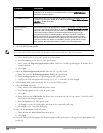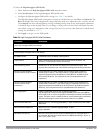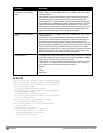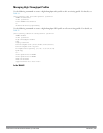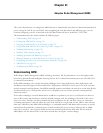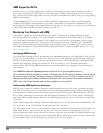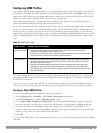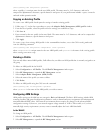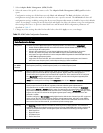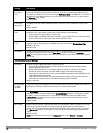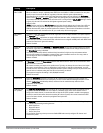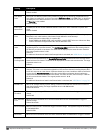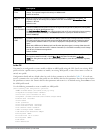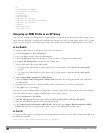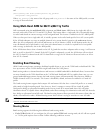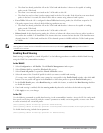
3. Select Adaptive Radio Management (ARM) Profile.
4. Select the name of the profile you want to edit. The Adaptive Radio Management (ARM) profile window
opens.
Configuration settings are divided into two tabs, Basic and Advanced. The Basic tab displays only those
configuration settings that often need to be adjusted to suit a specific network. The Advanced tab shows all
configuration settings, including settings that do not need frequent adjustment or should be kept at their default
values. If you change a setting on one tab then click and display the other tab without saving your configuration,
that setting will revert to its previous value. Both basic and advanced ARM configuration parameters are
described in Table 97.
5. Change any of the settings described in the table below, then click Apply to save your changes.
Setting Description
Basic Configuration Settings
Assignment Activates one of four ARM channel/power assignment modes. (The default value is single-band.)
l disable: Disables ARM calibration and reverts APs back to default channel and power settings
specified by the AP’s radio profile
l maintain: APs maintain their current channel and power settings. This setting can be used to
maintain AP channel and power levels after ARM has initially selected the best settings.
l multi-band: For single-radio APs, this value computes ARM assignments for both 5 GHZ (802.11a) and
2.4 GHZ (802.11b/g) frequency bands.
l single-band: For dual-radio APs, this value enables APs to change transmit power and channels
within their same frequency band, and to adapt to changing channel conditions.
Allowed bands
for 40MHz
channels
The specified setting allows ARM to determine if 40 MHz mode of operation is allowed on the 5 GHz or 2.4
GHz frequency band only, on both frequency bands, or on neither frequency band.
Max Tx EIRP Maximum effective isotropic radiated power (EIRP) from 3 to 33 dBm in 3 dBm increments. You may also
specify a special value of 127 dBm for regulatory maximum. Higher power level settings may be
constrained by local regulatory requirements and AP capabilities. In the event that an AP is configured
for a Max Tx EIRP setting it cannot support, this value will be reduced to the highest supported power
setting. The default value for this parameter is 127 dBm.
NOTE: Power settings will not change if the Assignment option is set to disabled or maintain.
Min Tx EIRP Minimum effective isotropic radiated power (EIRP) from 3 to 33 dBm in 3 dBm increments. You may also
specify a special value of 127 dBm for regulatory maximum to disable power adjustments for
environments such as outdoor mesh links. Note that power settings will not change if the Assignment
option is set to disabled or maintain. Higher power level settings may be constrained by local regulatory
requirements and AP capabilities. In the event that an AP is configured for a Min Tx EIRP setting it cannot
support, this value will be reduced to the highest supported power setting. The default value for this
parameter is 9 dBm.
Consider configuring a Min Tx Power setting higher than the default value if most of your APs are placed
on the ceiling. APs on a ceiling often have good line of sight between them, which will cause ARM to
decrease their power to prevent interference. However, if the wireless clients down on the floor do not
have such a clear line back to the AP, you could end up with coverage gaps.
Scanning The Scanning checkbox enables or disables AP scanning across multiple channels. This checkbox is
selected by default. Do not disable scanning unless you want to disable ARM and manually configure AP
channel and transmission power. Disabling this option also disables the following scanning features:
l Multi Band Scan
l Rogue AP Aware
l Voip Aware Scan
l Power Save Scan
Table 97:
ARM Profile Configuration Parameters
DellPowerConnectW-SeriesArubaOS6.2 | User Guide AdaptiveRadioManagement (ARM) | 350



